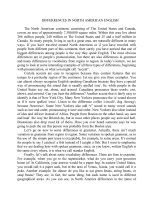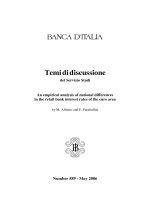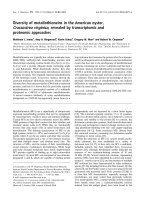Gender-based differences in compliments and compliment responses in the American comedy TV-series Ugly Betty
Bạn đang xem bản rút gọn của tài liệu. Xem và tải ngay bản đầy đủ của tài liệu tại đây (184.57 KB, 14 trang )
Gender-based differences in compliments and
compliment responses in the American comedy
TV-series "Ugly Betty"
Sự khác biệt trong cách thức khen và tiếp nhận
lời khen giữa các giới trong tiếng Anh qua bộ
phim truyền hình Mỹ "Ugly Betty"
Bùi Thị Ánh Ngọc
University of Languages and International studies
M.A. Thesis. English linguistics: 60 22 15
Supervisor: Ph.D. Kiều Thị Thu Hương
Năm bảo vệ: 2011
Abstract. This study examines the differences in compliment behavior and compliment
response strategies in American English between males and females. The data were
collected from the ten episodes in the first season of the American Comedy TV-series
“Ugly Betty”. The analysis of 167 compliment exchanges showed that there were
significant differences between males and females in giving compliments and using the
response strategies. Nevertheless, they still shared some common features. Regarding
compliment frequency, females tended to compliment other females more whereas
males complimented females far more than they complimented other males. In this
research, except for the topic of appearance, there was no significant statistic difference
in the choice of others compliment topics between the two genders. It should be noted
that male – female interactions complimenting on appearance took the first place. In
terms of functions, females used compliments most often to establish, confirm or
maintain solidarity while male compliments more often offered admiration. The
findings of the differences in response type frequencies from the two groups revealed
that there was more likelihood of non-agreement than agreement. It might be due to the
high frequency of no acknowledgement responses. In the light of these findings, several
pedagogical implications were drawn. Most importantly, English foreign language
teachers should show the learners how to appropriately compliment and respond in
communicative situations.
Keywords. Giao tiếp; Tiếng Anh; Phim truyền hình
Content.
INTRODUCTION
The introduction states the problem and the rationale of the study, together with the
aims, scope, methodology, the significance and the organization of the whole paper.
Above all, it is in this chapter that the research questions are set out to work as the
guidelines for the whole research.
1. Statement of the problem and rationale for the study
An effective language user is competent in not only linguistics but also pragmatics. As
Yule (1996) put it, “nothing in the use of the linguistic forms is inaccurate, but getting
the pragmatics wrong might be offensive” (p. 5-6). To be able to use a target language
appropriately in terms of pragmatic competence, language users should employ a
variety of speech acts. Complimenting is one of them.
Compliments not only express sincere admiration of positive qualities, but they also
replace greetings, thanks or apologies, and minimize face-threatening acts (henceforth
FTAs), such as criticism, scolding, or requests (Brown & Levinson, 1987; Holmes,
1988a; Wolfson, 1983, 1989). Complimenting is a tool of establishing friendship that
creates ties of solidarity in American culture. It is also an important social strategy that
functions as an opener for a conversation, allowing meaningful social interactions to
follow. Americans pay compliments so frequently that neglecting to do so can even be
interpreted as a sign of disapproval (Manes, 1983; Wolfson, 1989; Wolfson & Manes,
1980) and a wrong use of compliments may cause embarrassment and offense
(Dunham, 1992; Holmes & Brown, 1987).
Each culture requires various kinds of speech act behavior. Blum-Kulka, House and
Kasper (1989) found that “culturally colored interactional styles create culturally
determined expectations and interpretative strategies, and can lead to breakdowns in
intercultural and interethnic communication” (p. 30). In other words, when people from
different cultures interact, breakdowns in communication may happen due to signaling
different speech act strategies that reflect the culture‟s distinctive interactional style.
Complimenting is a particularly suitable speech act to investigate because it acts as a
window through which we can view what is valued in a particular culture. Thus, it is
essential for Vietnamese learners of English to know how to give appropriate
compliments and responses in English.
Complimenting is inevitably affected by social factors including gender. According to
Tannen (1990), gender differences are parallel to cross-cultural differences. Therefore,
it is worthwhile to study the interactions between men and women, men and men, or
women and women exchanging compliments and responses.
All those reasons stimulate the researcher to conduct a study on gender-based
differences in compliments and compliment responses in English conversations through
the American Comedy TV-series “Ugly Betty”. The people in the TV series are not real
people, but the actors are chosen to match the real ones in daily life. What can be
assumed is that the data would bare resemblance to real life language. Hopefully, the
study will make a contribution to the field which it is envisioned and fill the gaps in
previous research.
2. Aims of the study
First of all, the study sets out to investigate the gender-based differences in compliment
behavior including the frequency of compliments, compliment topics and the functions
of compliments. Secondly, the differences between males and females in compliments
response strategies are explored. The findings will pave the way for several pedagogical
and intercultural communication implications.
3. Research questions
The research seeks the answers to the following research questions:
Research question 1: What are the differences in compliment behavior between males
and females?
Research question 2: What are the differences in compliment responses between
males and females?
4. Scope of the study
There are four seasons in this TV-series with the total of 85 episodes. However, due to
the size and limitation of a preliminary research, the dialogues in the episodes one to
ten in the first season are used with the development of the story. Every episode takes
about 40 minutes. Totally, this study will analyze ten episodes of around 400 minutes.
The compliments among 18 characters balanced in gender, 9 females and 9 males, are
chosen. Some compliments are excluded from the present study: compliments to a place
or an object that does not belong to interactants, compliments to speakers themselves or
to a group of people, compliments from a group to a particular thing or a special person.
Furthermore, a compliment may be sincere or insincere. Mills (2003) stated:
The hearer might consider that the speaker is being insincere and is
only complimenting because he/she wants something – i.e. that it is
serving some longer term goal; or it might be interpreted as suggesting
that the person does not look good at all, but the speaker is being kind.
(p. 220)
Also, compliments can have an ironic meaning (Holmes, 1995, p. 119). For instance, if
the interlocutors are enemies, the compliments between them have ironic meanings.
Within the scope of an M.A. thesis, only sincere compliments are analyzed.
5. Methodology
Quantitative and qualitative methods are both used in this paper with priorities given to
the quantitative one. In other words, all the conclusions and considerations are based on
the analysis of the empirical studies and statistics processed on Stata 10, a software
program commonly used in social sciences. In addition, such methods as descriptive,
analytic, comparative and contrastive are also utilized to describe and analyze, to
compare and contrast the database so as to find out gender-based differences in
compliments‟ frequency, topics and functions and types of compliment response
strategies.
6. Significance of the study
The present study is conducted to find out the influences of gender on compliment
behavior and compliment response strategies in English. It will add to the research on
compliments and second language acquisition. Regarding researchers who share the
same interest in the topic, they could rely on this paper to get useful information for
their future studies.
Besides, the study could help Vietnamese learners of English to be aware of
sociolinguistic aspects of English and thus to improve their pragmatic competence. As
for teachers of English, the findings from this paper may have crucial pedagogical
implications for practice of teaching English as a foreign language.
7. Organization of the study
After the Introduction, the rest of the paper includes the following parts:
Chapter 1 (Literature Review) provides the background of the study including the
definitions of key concepts and the discussions of related studies.
Chapter 2 (The study) describes the procedures to conduct the research, presents,
analyzes the results and discusses the findings the researcher obtained according to the
two research questions.
Conclusion summarizes the main issues discussed in the paper, provides some
implications and points out the limitations of the research as well as proposes several
suggestions for further studies. Following this part are References and Appendix.
References.
ENGLISH
Austin, J. L. (1962). How to do things with words. New York: Oxford University Press.
Baek, G. (1998). A cross-cultural study of compliments and compliment responses in
English and Korean. Seoul National University, Seoul.
Barnlund, D. & Araki, S. (1985). Intercultural encounters: The management of
compliments by Japanese and Americans. Journal of Cross-cultural Psychology,
16(1), 9-26.
Berger, C. R. (1985). Social power and interpersonal communication. In M. Knapp &
G. Miller (Eds.), Handbook of interpersonal communication (pp. 439-499).
London: Sage.
Blum-Kulka, S. (1989). Playing it safe: the role of conventionality in indirectness. In S.
Blum-Kulka, J. House, & G. Kasper (Eds.), Cross-cultural pragmatics: Requests
and apologies (pp. 37-70). Norwood, NJ: Ablex Publishing Company.
Blum-Kulka, S., House, J., & Kasper, G. (1989). Cross-cultural pragmatics: Request
and apologies. Norwood, NJ: Ablex Publishing Company.
Brown, P. (1980). How and why are women more polite: Some evidence from a Mayan
community. In S. McConnell-Ginet, R. Borker, & N. Furman (Eds.). Women and
language in literature and society. New York, Praeger.
Brown, P. (1983). Gender, politeness and confrontation in Tenejapa. In D. Tannen (Ed.)
Gender and conversational interaction. Oxford: Oxford University Press.
Brown, P., & Levinson, S. (1987). Politeness: Some universals in language usage.
Cambridge: Cambridge University Press.
Butler, J. (1990). Gender trouble: Feminism and the subversion of identity. New York
and London: Routledge.
Cameron, D. (2002). Working with spoken discourse. Sage Publications.
Canary, D.J. & Dindia, K. (Eds.) (1998). Sex differences and similarities in
communication : Critical essays and empirical investigations of sex and gender
in interaction. Lawrence Erlbaum Associates, Inc., Publishers
Cedar, P. (2006). Thai and American responses to compliments in English. The
Linguistics Journal, 1(2), 6-28.
Celce-Murcia, M. (1991). Discourse analysis and grammar instruction. In W. Grabe
(Ed.), Annual review of Applied Linguistics (pp. 135-151). New York :
Cambridge University Press.
Celce-Murcia, M. & Olshtain, E. (2000). Discourse and context in language teaching:
A guide for language teachers. Cambridge University Press.
Chambers, J. C. (1992). Linguistic correlates of gender and sex. English World Wide,
13, 173-218.
Coates, J. (2004). Women, men and language – A sociolinguistic account of gender
differences in language. Harlow: Longman.
Coates, J. & Cameron, D. (Eds.) (1989). Women in their speech communities: New
perspectives on language and sex. New York: Longman.
Crawford, M. (1995). Talking difference on gender and language. SAGE Publications
Ltd.
Crawford, M, & MacLeod, M. (1990). Gender in the college classrooms: an assessment
of the „chilly climate‟ for women. Sex Roles, 23, 101-122.
Daikuhara, M. (1986). A study of compliments from a cross-cultural perspective:
Japanese vs. American English. Working Papers in Educational Linguistics,
2(2), 103-134.
David, B. (2008). Compliment responses across gender. Pragmatics and Intercultural
Communication, 1(2), 76-87.
DeFrancisso, V. (1991). The sounds of silence: how men silence women in marital
relations. Discourse and Society, 2, 413-423.
Dubois, B. & Crouch, I. (1975). The question of tag questions in women‟s speech: They
really don‟t use more of them. Language in Society, 4, 289-294.
Dunham, P. (1992). Using compliments in the ESL classroom: An analysis of culture
and gender. MinneTESOL, 10, 75-85.
Eagly, A. H. & Johnson, B. T. (1990). Gender and leadership style: A meta-analysis.
Psychological Bulletin, 108(2), 233-256.
Eakins, B. & Eakins, G. (1976). Verbal turn-taking and exchanges in faculty dialogue.
In B. L. Dubois & I. Crouch (Eds.), The sociology of the languages of American
women. San Antonio, TX: Trinity University.
Eakins, B. & Eakins, G. (1983). Verbal turn-taking and exchanges in faculty dialogue.
In Dubois, B. L. & Crouch, I. (Eds.), Proceedings of the conference on the
sociology of the languages of American women (pp. 53-62). San Antonio, TX:
Trinity University Press.
Eckert, P. & McConnell-Ginet, S. (2003). Language and gender. Cambridge University
Press.
Ervin-Tripp, S. M. (1979). Children's verbal turn-taking. In E. Ochs & B. Schieffelin
(Eds.), Developmental pragmatics (pp. 391-414). New York: Academic Press.
Fausto-Sterling, A. (2000). Sexing the body: Gender politics and the construction of
sexuality. New York: Basic Books.
Fishman, P. (1978). Interaction: the work women do. Social Problems, 25, 397-406.
Fraser, B. (1990). Perspectives on politeness. Journal of Pragmatics, 14, 219-236.
Gajaseni, C. (1994) A contrastive study of compliment responses in American English
and Thai including the effect of gender and social status. University of Illinois at
Urbana-Champaign.
Gender, women and health. World Health Organization. Retrieved September 28, 2010,
from
Gorila, M. (2007). Ugly Betty – First season subtitles. Retrieved September 22, 2010,
from
Greif, E. B. (1980). Sex differences in parent-child conversations. Women’s Studies
International Quarterly, 3, 253-258.
Grice, P. (1968). Studies in the Way of Words. Harvard.
Gu, Y. (1990). Politeness phenomena in modern Chinese. Journal of Pragmatics, 14,
237-257.
Hall, J. A. & Veccia, E. M. (1990). More “touching” observations: New insights on
men, women, and interpersonal touch. Journal of Personality and Social
Psychology, 59, 1155-1162.
Halliday, M. A. K. (1991). The notion of “context” in language education. In T. Le &
M. McCausland (Eds.), Language education: International developments (pp. 4-
26).
Hare-Mustin, R. & Marecek, J. (1988). The meaning of difference: gender theory, post-
modernism, and psychology. American Psychologist, 43, 455-464.
Hatch, E. (1992). Speech acts and speech events. In E. Hatch, Discourse and language
education (pp. 121-163). Cambridge: Cambridge University Press.
Henley, N. (1973-1974). Power, sex, and nonverbal communication. Berkeley Journal
of Sociology, 18, 1-26.
Henley, N. (1977). Body politics: Power, sex, and nonverbal communication.
Englewood Cliffs, NJ: Prentice-Hall.
Herbert, R. K. (1986). Say “thank you” – Or something. American Speech, 61, 76-78.
Herbert, R. K. (1989). The ethnography of English compliment and compliment
responses: A contrastive sketch. In W. Oleksy, Contrastive pragmatics (pp. 3-
36). Amsterdam: John Benjamins Publishing Company.
Herbert, R. K. (1990). Sex-based differences in compliment behavior. Language in
Society, 19, 201-224.
Herbert, R. K. (1998). Sex-based differences in compliment behavior. In J. Cheshire &
P. Trudgill (Eds.), The Sociolinguistics Reader 2: Gender and Discourse (pp. 53-
75). Arnold, London.
Herbert, R. K. & Straight, H. S. (1989). Compliment-rejection vs. compliment
avoidance. Language and Communication, 9, 35-47.
Holmes, J. (1984). Women‟s language: A functional approach. General Linguistics,
24(3), 149-178.
Holmes, J. (1988a). Compliments and compliment responses in New Zealand English.
Anthropological Linguistics, 28, 485-508.
Holmes, J. (1988b). Paying compliments: A sex-preferential positive politeness
strategy. Journal of Pragmatics, 12, 455-465.
Holmes, J. (1991). Language and gender. Language Teaching, 24(4), 207-220.
Holmes, J. (1992). An Introduction to sociolinguistics. London.
Holmes, J. (1995). Women, men and politeness. Longman Publishing, New York.
Holmes, J. (1998). Women‟s talk: The question of sociolinguistic universals. In J.
Coates (Ed.), Language and Gender: A Reader (pp. 461-483). Oxford.
Holmes, J. & Brown, D. F. (1987). Teachers and students learning about compliments.
TESOL Quarterly, 21(3), 523-546.
Jones, D. (1980). Gossip: notes on women‟s oral culture‟. In C. Kramarae (Ed.), The
voices and words of women and men (pp. 193-198). Pergamon Press, Oxford.
Kerbrat-Orecchioni, C. (1987). La description des échanges en analyse
conversationnelle: L‟exemple du compliment. DRLAV – Revue de Linguistique,
36-37, 1-53.
Kiều, T. T. H. (2006). Disagreeing in English and Vietnamese: A Pragmatics and
conversation analysis perspective. Unpublished paper submitted for the degree
of Doctor of Philosophy. University of Languages and International Studies,
Vietnam National University, Hanoi.
Knapp, M. L., Hopper, R., & Bell, R. A. (1984). Compliments: A descriptive
taxonomy. Journal of Communication, 34(4), 2-31.
Kollock, P., Blumstein, P. & Schwartz, P. (1985). Sex and power in interaction:
Conversational privileges and duties. American Sociological Review, 50, 34-46.
Kramarae, C. (1981). Men and women speaking. Rowley, MA: Newbury House.
Kramer, C. (1977). Perceptions of female and male speech. Language and Speech, 20,
151-161.
Lakoff, R. (1972). Language in context. Language, 48(40), 907-927.
Lakoff, R. (1973). The social context of language use. Lecture delivered at the
Linguistic Summer Institute. Ann Arbor.
Lakoff, R. (1975). Language and women’s place. New York: Harper and Row.
Leech, G. (1983). Principles of pragmatics. Longman: Essex.
Leet-Pellegrini, H. M. (1980). Conversational dominance as a function of gender and
expertise. In H. Giles, W. P. Robinson & P. M. Smith (Eds.), Language: social
psychological perspectives. Oxford: Pergamon.
Levinson, S. C. (1983). Principles of pragmatics. London: Longman.
Longman Dictionary of Contemporary English. (2004). Beijing: Foreign Language
Teaching and Research Press.
Lorenzo-Dus, N. (2001). Compliment responses among British and Spanish university
students: A contrastive study. Journal of Pragmatics, 33(7), 127.
Maltz, D. & Borker, R (1982). A cultural approach to male-female miscommunication.
In J. Gumperz (Ed.) (1998). Language and Social Identity (pp. 281-312).
Oxford. Also in J. Coates (Ed.) (1998): Language and Gender: A Reader (pp.
415-434). Oxford.
Manes, J. (1983). Compliments: A mirror of cultural values. In N. Wolfson & E. Judd.
(Eds.), Sociolinguistics and language acquisition (pp. 88-95). Rowley, MA:
Newbury House.
Manes J. & Wolfson N. (1981). The compliment formula. In F. Coumas (Ed.) (1994),
Conversational routine: Explorations in standardized communication situations
and prepatterned speech (pp. 115-132). The Hague: Mouton.
Mey, J. (2001). Pragmatics: An introduction (2nd ed.). Malden, MA: Blackwell.
Mills, S. (2003). Gender and politeness. Cambridge University Press.
Moskowitz, D. S., Jung Suh, E., & Desaulniers, J. (1994). Situational influences on
gender differences in agency and communion. Journal of Personality and Social
Psychology, 66(4), 753-761.
Nelson, L. G., Al-Batal, M. & Echols, E. (1996). Arabic and English compliment
responses: Potential for pragmatic failure. Applied Linguistics, 17(4), 411-432.
Nelson L. G., El Bakary, W. & Al Batal M. (1993). Egyptian and American
compliments: A cross-cultural study. International Journal of Intercultural
Relations, 17(3), 293-313
Nguyễn, H. (2000). An introduction to discourse analysis. Vietnam National University
Press.
Norrick, N. (1980). The speech act of complimenting. In E. Hovdhaugen (Ed.), The
Nordic languages and modern linguistics (pp. 296-304). Oslo:
Universitetsforlaget.
Parisi, C. & Wogan, P. (2006). Compliment topics and gender. Women and Language,
29, 21–28.
Pinker, S. (2007). The evolutionary social psychology of off-record indirect speech
acts. Intercultural Pragmatics, 4(4), 437-461.
Pomerantz, A. (1978). Compliment responses: Notes on the co-operation of multiple
constraints. In J. Schenkein (Ed.), Studies in the organization of conversation
interaction. Academic Press.
Pridam, F. (2001). The language of conversation. London: Routledge.
Richards, J. C. (1983). Communicative needs in foreign language learning”. In Wolfson
& Judd (Eds.), Sociolinguistics and language Acquisition. Newbury House
Publishers.
Richards, J. C. (1985). The context of language teaching. Cambridge: Cambridge
University Press.
Sadker, M. & Sadker, D. (1994). Failing at fairness: how America’s schools cheat
girls. New York: Scribners.
Savignon, S. (1997). Communicative competence theory and classroom practice: Texts
and contexts in second language learning. McGraw Hill.
Searle, J. R. (1975). Indirect speech acts. In P. Cole & J. L. Morgan (Eds.), Syntax and
semantics (pp. 60-61). New York: NY: Academic Press.
Searle, J. R. (1969). Speech acts. Oxford: Cambridge University Press.
Searle, J. R. (1976). A classification of Illocutionary acts. Language in Society, 5, 1-23.
Searle, J. R. (1979). Expression and meaning: Studies in the theory of speech acts.
Cambridge: Cambridge University Press.
Sherman, J. (1978). Sex-related cognitive differences: An essay on theory and evidence.
Springfield, IL.
Smith-Hefner, N. (1988). Women and politeness: the Javanese example. Language and
Society, 17, 535-554.
Spender, D. (1980). Man made language. London: Routledge & Kegan Paul.
Spender, D. (1989). The writing or the sex. New York: Pergamon Press.
Stern, H. (1983). Fundamental concepts of language teaching. London. Oxford: Oxford
University Press.
Stier, D. S., & Hall, J. A. (1984). Gender differences in touch: An empirical and
theoretical review. Journal of Personality and Social Psychology, 47, 440-459.
Tannen, D. (1987). That’s not what I meant! How conversational style makes or breaks
relationships. New York: Ballantine.
Tannen, D. (1990). You just don’t understand: Women and men in conversation. New
York: Ballantine Books.
Tannen, D. (1994). Gender and discourse. Oxford University Press.
Thomas, J. (1995). Meaning in interaction: An Introduction to Pragmatics. USA,
England: Longman.
Thorne, B. & Henley, N. (1975). Difference and dominance: An overview of language,
gender and society. In B. Thorne & N. Henley (Eds.), Language and sex:
Difference and dominance (pp. 5-42). Rowley, MA: Newbury House.
Trudgill, P. (1972). Sex, covert prestige and linguistic change in the urban British
dialect of Norwich. Language and Society, 1, 179-195.
Trudgill, P. (1978). Sociolinguistic patterns in British English. London.
Unger, R. K. (1976). Male is greater than female: The socialization of status inequality.
Counseling Psychologist, 6(2), 2-9.
Unger, R. K. (1979). Female and male: Psychological perspectives. New York: Harper
& Row.
West. C. (1984). When the doctor is a lady. Symbolic Interaction, 7(1), 87-106.
West, C. & Zimmerman, D. (1977). Women‟s place in everyday talk: Reflections on
parent-child interaction. Social Problems, 24, 521-529.
West, C. & Zimmerman, D. (1987). Doing gender. Gender and Society, 1, 125-151.
Wolfson, N. (1981). Compliments in cross-cultural perspective. TESOL quarterly, 15.
Wolfson, N. (1983). An empirically based analysis of complimenting in American
English. In N. Wolfson & E. Judd (Eds.), Sociolinguistics and language
acquisition. Rowley, Massachusetts: Newbury House.
Wolfson, N. (1984). Pretty is as pretty does: A speech act view of sex roles. Applied
Linguistics, 5(3).
Wolfson, N. (1988). The bulge: A theory of speech behavior and social distance. In J.
Fine (Ed.), Second language discourse: A textbook of current research (pp. 21-
38). Norwood, NJ: Ablex.
Wolfson, N. (1989). Perspectives: Sociolinguistics and TESOL. Rowley, MA: Newbury
House.
Wolfson, N., & Manes, J. (1980). The compliments as a social strategy. Interactional
Journal of Human Communication, 13(3), 410-451.
Woods, N. (1988). Talking shop: Sex and status as determinants of floor apportionment
in a work setting. In J. Coates & D. Cameron (Eds.), Women in their speech
communities: New perspectives in language and sex (pp. 141-157). New York:
Longman.
Ye, L. (1995). Complimenting in mandarin Chinese. In G. Kasper (Ed). Pragmatics of
Chinese as native and target language. University of Hawaii, USA.
Yoko, U. (1995). Japanese Compliment Responses: A Comparison to American English
Norms. Japan Journal of Multilingualism and Multiculturalism, 1(1).
Yule, G. (1996). Pragmatics. Oxford: Oxford University Press.
Zimmerman, D. & West, C. (1975). Sex Roles, Interruptions and Silences in
Conversations. In B. Thorne & N. Henley (Eds.) (1975), Language and Sex:
Difference and dominance (pp. 105-129). Rowley, MA: Newbury House.
VIETNAMESE
Nguyễn, Q. (1998). Một số khác biệt giao tiếp lời nói Việt-Mỹ trong cách thức khen và
tiếp nhận lời khen. Luận án tiến sĩ khoa học ngữ văn. ĐH KHXH & NV,
ĐHQGHN.









